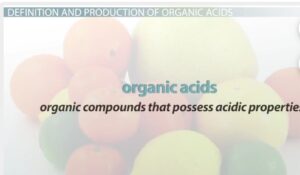What is an Acid?
An acid is a substance which produces hydrogen ions, H+
, as the only positively charged ion in aqueous solution.

Classes/Types Of Acids
There are two major types of acids namely:
Organic acids and Inorganic/mineral acids.
Organic Acids : Organic acids are acids gotten from organic matters or natural products in plants and animals. Examples of organic acids are citric acids:
ethanoic acids
lactic acid
Ascorbic acid
fatty acids
Sources Of Organic Acids
Lime, lemon, vinegar, sour milk, oranges, fatty/oil, pears.
Inorganic Acid: Inorganic or mineral acids are acid prepared from mineral elements or prepared from mineral elements or inorganic
matter. Examples
- Weak acid:
A weak acid is an acid that ionizes partially in water. The concentration of H+ in the solution is low.
Examples are H2
CO3
, H3
PO4
, CH3
COOH.
- Acid concentration:
Concentration of an acid depends on then umber of moles of its solute dissolved in a given volume of the solvent. They are:
- Concentrated acid and
Diluted acid.
Concentrated Acid: concentrated acid is an acid that contains
very little or no amount of water.
Diluted Acids: it is an acid that contains large amount of water
relative to the amount of acid.
1.
2.
3.
Inorganic Acids, Formular, And Component Elements.
Hydrochloric acid, Hcl, comprises of Hydrogen and chlorine
Trioxonitrate (v) acid HNO3
comprises of hydrogen and
nitrogen
Tetraoxosulphate (iv) acid, H2
SO4
comprises of hydrogen,
sulphur, and oxygen.
Acid strength:The strength of an acid depends on its ability to
ionize in solution. They are: Strong and Weak acids:
Strong acids: A strong acid is an acid that ionizes completely in
water to produce hydrogen ions. The Concentration of H+
is
very high in the solution. E.g. H2
SO4
, Hcl, HNO3
.
Preparation Of Acids
Action of water on acid anhydride on water CO2(s)
+H2
0(l)
–
H2
C03(aq)
.
Direct combination of constituents elements H2(g)
+Cl
2(g)
–
2Hcl
(g)
Displacement of weaker acid from its salt by a strong acid in
solution (displacement reaction).
Chemical Properties Of Acids
1.Acids turn blue litmus paper red.
2.They give hydrogen gas on reacting with
active metals. 2HCL(aq)
+Zn(s)
_Zncl
2 (aq)
+H2(g)
3.
Acids react with base to produce salt and water
only. This reaction is calleNdeutralization
Reaction.
4.They liberate carbon (iv) CO2
from
trioxocarbonate (iv),CO3
and hydrogen
trioxocarbonate (iv) HCO3
.
Basicity of Acids The basIcity of an acid shows
the number of replaceable hydrogen ion found
in the acid.
Hcl H+ + Cl
– 1 or monobasic
CH3
COOH H+ + CH3
COOH 1 or monobasic
H2
SO4
2H+ + S04
2- 2 or dibasic
H3
P04
- 3H+ + P04
– 3 or tribasic
Physical Properties Of Acids
1.Acid turns blue litmus paper red.
2.Acids have sour taste.
3.concentrated acids are very corrosive.



